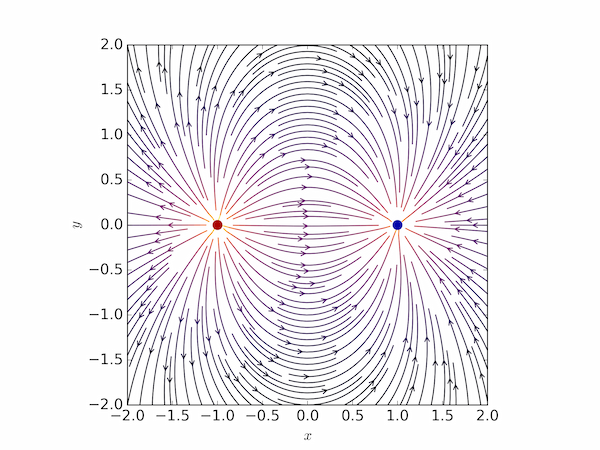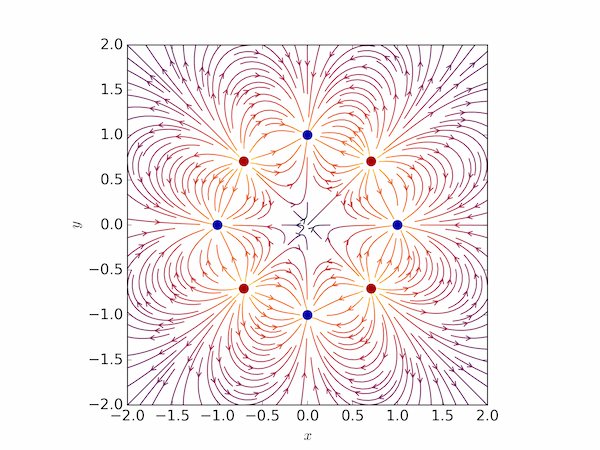Visualizing a vector field with Matplotlib
Posted on 10 December 2015
Matplotlib provides a function, streamplot, to create a plot of streamlines representing a vector field. The following program displays a representation of the electric field vector resulting from a multipole arrangement of charges. The multipole is selected as a power of 2 on the command line (1=dipole, 2=quadrupole, etc.)
It requires Matplotlib 1.5+ because of the choice of colormap (plt.cm.inferno): this can be replaced with another (for example plt.cm.hot) if using an older version of Matplotlib.
import sys
import numpy as np
import matplotlib.pyplot as plt
from matplotlib.patches import Circle
def E(q, r0, x, y):
"""Return the electric field vector E=(Ex,Ey) due to charge q at r0."""
den = np.hypot(x-r0[0], y-r0[1])**3
return q * (x - r0[0]) / den, q * (y - r0[1]) / den
# Grid of x, y points
nx, ny = 64, 64
x = np.linspace(-2, 2, nx)
y = np.linspace(-2, 2, ny)
X, Y = np.meshgrid(x, y)
# Create a multipole with nq charges of alternating sign, equally spaced
# on the unit circle.
nq = 2**int(sys.argv[1])
charges = []
for i in range(nq):
q = i%2 * 2 - 1
charges.append((q, (np.cos(2*np.pi*i/nq), np.sin(2*np.pi*i/nq))))
# Electric field vector, E=(Ex, Ey), as separate components
Ex, Ey = np.zeros((ny, nx)), np.zeros((ny, nx))
for charge in charges:
ex, ey = E(*charge, x=X, y=Y)
Ex += ex
Ey += ey
fig = plt.figure()
ax = fig.add_subplot(111)
# Plot the streamlines with an appropriate colormap and arrow style
color = 2 * np.log(np.hypot(Ex, Ey))
ax.streamplot(x, y, Ex, Ey, color=color, linewidth=1, cmap=plt.cm.inferno,
density=2, arrowstyle='->', arrowsize=1.5)
# Add filled circles for the charges themselves
charge_colors = {True: '#aa0000', False: '#0000aa'}
for q, pos in charges:
ax.add_artist(Circle(pos, 0.05, color=charge_colors[q>0]))
ax.set_xlabel('$x$')
ax.set_ylabel('$y$')
ax.set_xlim(-2,2)
ax.set_ylim(-2,2)
ax.set_aspect('equal')
plt.show()
The electric field of a dipole: $ python efield.py 1

The electric field of an octopole: $ python efield.py 3
